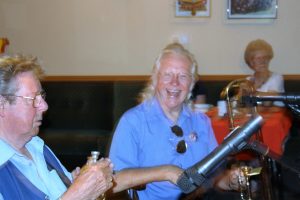
How about this photo of our beaming ‘Kid’, George Tidiman on trombone, seen here with Ken Simms on trumpet. Taken at Farnborough Jazz Club (Kent) on 22nd July 2016 with his own band – George ‘Kid’ Tidiman’s All Stars. Photo:Mike Witt.
It’s Our ‘Kid’ GEORGE TIDIMAN on trombone, back again to play for us. What a happy atmosphere he brings to us too, especially as he has booked the best – DENNY ILETT on trumpet, with TIM HUSKISSON on clarinet, ‘SOUTHEND BOB’ ALLBUT on banjo & vocals( and what vocals), JOHN SIRETT on double bass and BILL FINCH on drums. Great dancing and great laughter can be seen and heard – you betcha. That will be here at Farnborough Jazz Club this Friday, 24th March 2017. Hey, must remind you, our clocks spring forward 1 hour at 1:00am Sunday morning. Yeah – that means Spring Time is really here – Yippee!
Diane and Keith, your hosts for some great jazz.
Early history (taken from /see Wikipedia for more info, go to: https://en.wikipedia.org/wiki/British_Summer)
British Summer Time was first established by the Summer Time Act 1916, after a campaign by builder William Willett. His original proposal was to move the clocks forward by 80 minutes, in 20-minute weekly steps on Sundays in April and by the reverse procedure in September.[6] In 1916 BST began on 21 May and ended on 1 October.[7] Willett never got to see his idea implemented as he died in early 1915.
Periods of deviation[edit]
In 1940, during the Second World War, the clocks in Britain were not put back by an hour at the end of summer. In subsequent years, clocks continued to be advanced by one hour each spring and put back by an hour each autumn until July 1945. During these summers, therefore, Britain was two hours ahead of GMT and operating on British Double Summer Time (BDST). The clocks were brought back in line with GMT at the end of summer in 1945. In 1947, due to severe fuel shortages, clocks were advanced by one hour on two occasions during the spring, and put back by one hour on two occasions during the autumn, meaning that Britain was back on BDST during that summer.[not in citation given][not in citation given][8]
An inquiry during the winter of 1959–60, in which 180 national organisations were consulted, revealed a slight preference for a change to all-year GMT+1, but instead the length of summer time was extended as a trial.[9] A further inquiry during 1966–67 led the government of Harold Wilson to introduce the British Standard Time experiment, with Britain remaining on GMT+1 throughout the year. This took place between 27 October 1968 and 31 October 1971, when there was a reversion to the previous arrangement.
Analysis of accident data for the first two years of the experiment, published by HMSO in October 1970, indicated that while there had been an increase in casualties in the morning, there had been a substantially greater decrease in casualties in the evening, with a total of around 2,500 fewer people killed and seriously injured during the first two winters of the experiment,[10][11] at a time when about 1,000 people a day were killed or injured on the roads.[12][13] However the period coincided with the introduction of Drink-Driving legislation, and the estimates were later modified downwards in 1989.[11]
The trial was the subject of a House of Commons debate on 2 December 1970[14] when, on a free vote, the House of Commons voted by 366 to 81 votes to end the experiment.[15]
